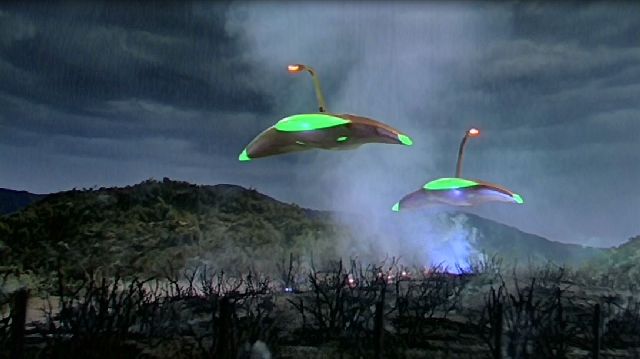The War of the Worlds (1953) 
“They came to CONQUER the EARTH!”

Director: Byron Haskin
Cast: Gene Barry, Ann Robinson, Les Tremayne
Synopsis: The film adaptation of the H.G.Wells story told on radio of the invasion of Earth by Martians.
The first thing that struck me about George Pal’s 1950s adaptation of H. G. Wells’ War of the Worlds was its meagre running time. Just 85 minutes to depict such a monumental event as the invasion of the entire planet by Martians. I somehow remembered it being a lot longer from childhood viewings, and you’d expect such a story to run around at least a couple of hours, which is perhaps why it feels as if the more personal side of the story is under-explored at times. Of course, this isn’t necessarily a bad thing as there can’t be many of us who watch an alien invasion movie to be blown away by the emotional resonance of the relationship between the male and female lead…
After an unnecessary introduction during which an unidentified narrator informs us on the development of human warfare in the 20th Century, we hear the familiar narration that begins with the words ‘No-one would have believed…’ which sound somehow inadequate when not spoken in Richard Burton’s mellifluous tones (Cedric Hardwicke does the duties here). A meteorite falls to earth and immediately becomes the object of intense curiosity from the locals of a small town near the San Gabriel Mountains.
Interestingly, their immediately reaction is to speculate about the lucrative financial potential of the meteorite. As luck would have it, a group of scientists just happen to be fishing nearby and hunky Dr. Clayton Forrester (Gene Barry) takes a trip out to the point of impact. Usually, hunkiness might preclude a leading man from playing an intelligent type, but Barry occasionally dons horn-rimmed spectacles to denote the intelligence that lurks behind those looks. Anyway, it’s at the alien’s landing point that he meets local girl Sylvia van Buren (Ann Robinson), whose Uncle Matthew (Lewis Martin), the local pastor, invites Forrester to stay at their home.
They did things a lot differently back in the 1950s, so instead of the area being cordoned off and heavily guarded by armed militia, three local townsfolk, who make up a broad spectrum of the American social strata of the era, are left behind to keep an eye on things while everyone else goes home to attend the big Saturday Night Barn Dance. When they notice a concealed lid in the meteorite being unscrewed from within, they perhaps rashly step forward to form an impromptu welcoming committee. Unfortunately, as we know, these particular visitors aren’t here to make friends with the neighbours, and all three men are instantly vaporised. The Martian machines were apparently based on the shapes of cobras, swans and manta rays; and while they might look a bit like a flexible lamp poking out of some kind of games console, there also a gracefulness about them as they float in the air and issue lurid green death rays in all directions. While all of the special effects in the movie are highly ambitious and effective for the era — apparently they accounted for 70% of the movie’s budget — it’s these sleek carriers of death that remain in the memory and have become the movie’s iconic image, and it’s to art director Albert Nozaki’s credit that the film still looks good today, despite the fact that much of it is set-bound.
The Martian’s first attack wipes out the power in the town, and Forrester returns to the site when it transpires that everyone’s watches have stopped and that someone’s pocket compass points in the direction of the meteorites instead of North. ‘This is amazing!’ he declares with a nerdish grin, in a tone of voice reminiscent of Leonard Hofstadter (yes, he’s wearing his horn-rims, and no, he’s doesn’t realise that those three vaguely human-shaped piles of ash were once local townspeople), but his excitement quickly evaporates when the ship zaps a cowardly deputy officer. From this point on, events quickly escalate as we learn that these spaceships have landed in major cities around the world and that the future of the entire human race is at stake.
While The War of the Worlds provides a fast-moving, entertaining vision of Wells’ work it’s not without its faults. Key scenes explaining the escalating campaign of the Martians and the human’s inability to withstand their onslaught take place in Washington which, as the seat of power, would undoubtedly have been the first target of any invasion. And on the rare occasions when they venture outside of their impressive ships, the Martians look particularly unconvincing, even for the 1950s, and their blobby shape raises the question of just how they would be able to physically manufacture those ships. But these are pretty small gripes in an otherwise engaging sf classic that has managed to withstand the test of time.
(Reviewed 13th September 2013)
httpv://www.youtube.com/watch?v=P9T9f3UbGuo
